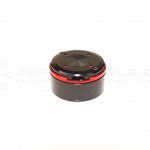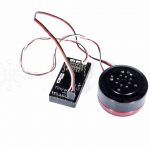Basecamelectronics Alexmos New Firmware Release 2.60B4
New features
- New enhanced PID auto-tuning algorithm:
- Fast and reliable;
- Finds most optimal PID gains to minimize error of stabilization and prevent self-excitation;
- Flexible: can tune PID from zero or slightly adjust gains starting from the current values;
- Able to tune other parameters, like low-pass filters;
- Has safety interrupts to prevent damage in case of wrong system operation;
- No GUI connection is required – can be run by the menu button command;
- Allows to update PID settings in all profiles;
- New settings “Filters” – “D-term LPF filters” that can help to remove high-frequency oscillations in some setups and allows to set greater PID gains
- Notch filters are extended: can be used as peak filter; gain is set in dB instead of %
- Acceleration limiter setting is split per-axis
- New types of encoders are supported for YAW axis in the regular firmware: PWM and I2C.
- New option “PID Gain multiplier” to extend the range of PID settings or link PID gain to adjustable variables, to tune it on-line by the analog potentiometer or RC.
- Serial API was extended by many new commands
- Option to disable of using gyro signal from the frame IMU for stabilization, but keep it for a frame angle detection; option to pass it through low-pass filter with adjustable cut-off frequency. Both options are useful in the case of high level of vibrations on the frame.
- Add a support of MavLink protocol for Ardupilot FC connection (beta state), that allows to increase a precision of stabilization and control over gimbal in automated missions.
- Option to backup/restore IMU calibrations to a file
- (Encoder version) Motor over-heating protection is improved: more precise model, virtual temperature is shown in the GUI to simplify tuning process; new safety action: alarm and cut-off motors
- (Encoder version) “Encoder field offset” parameter is calibrated automatically, no frame movement is required.
- Parameter “Magnetic linkage of a motor” will improve precision of stabilization; new auto-calibration function for this parameter
- Angle of motors can be used as a source in the “Adjustable Variables” to set a dependency of the system parameters on the camera-to-frame relative position, set by the inner (counting from the camera) and the middle motor’s angles
- Option to enable 3rd serial port: UART2 (Rx: AUX3, Tx: n/c); option to swap pins with the RC_SERIAL port (Rx: RC_ROLL, Tx: RC_YAW). In the encoder-enabled version, ports are swapped by default.
- New menu commands to switch to selfie mode by rotating camera 180 degrees from current position or 0/180 relative to home position, by the YAW axis.
- Several new commands in scripting language; option to use dynamic variables linked to the RC signal sources
- Option to automatically switch to upside-down mode (both frame and camera) and auto-rotate camera when frame is rotated +-180 degrees over PITCH axis.
Bugfixes
- Fixed problems with USB connection in “Tiny” boards
- RC control is slightly improved: smoother “Angle” mode, no overshoot after fast breaks
- Script parser: properly handles speed below 0.07 degree/sec for very slow time-lapses
- Fixed problems with the firmware upgrade under modern MacOS versions
- Many minor improvements of the system performance in various conditions
GUI Windows, OS X, LinuxSimpleBGC_GUI_2_60b4.zip
User Manual EnglishSimpleBGC_32bit_manual_2_6x_eng.pdf






